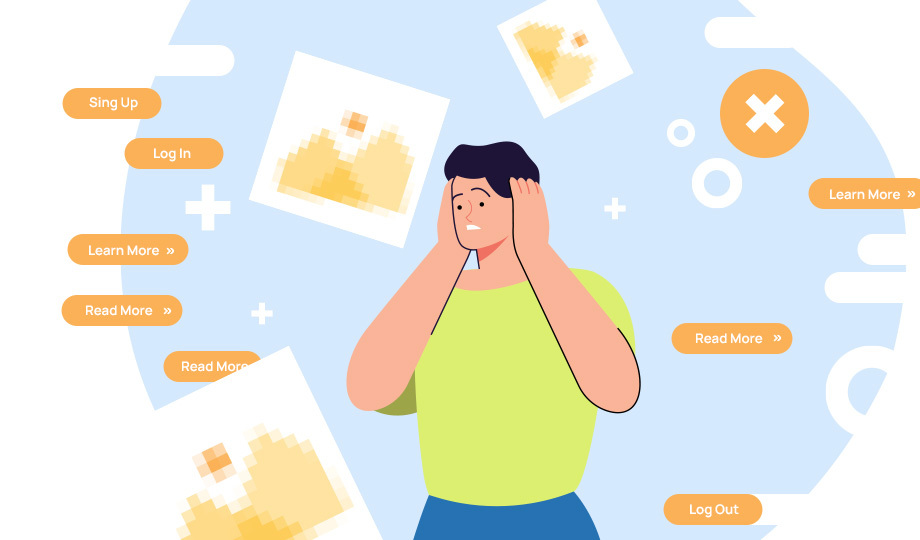The Seven Deadly Sins in UI/UX Design

We all know the maxim that the customer is always right. This is true because regardless of where they are – a physical store or an online website, the decision to buy or not to buy is ultimately in their hands.
When it comes to the online purchasing experience, it all comes down to exactly these two senses – touch and sight. Naturally, we are all drawn to visually appealing and logically intuitive digital interactions. The bad ones scare people away while the good ones lure them in.
This is why the role of UI&UX designers is so important. They are tasked with the responsibility of arranging the digital home of your business so that your visitors feel invited. Once they feel at home, they are one step closer to deciding whether or not to trust your products or services, or alternatively, turn to your competitors.
We have come up with a list of some of the deadliest sins that UI/UX designers often commit. These are the big “no-nos” that every designer should run away from like a cat from a bath.
#1 The “Where-The-Hell-Should-I-Click” Dilemma
Having too many CTA (call-to-action) buttons on a landing page can make things confusing and overwhelming for users, making it tricky for them to figure out where to click or what steps to take next. It gives off the vibe that the website is complex and not user-friendly, and nobody wants that kind of experience.
Besides, websites overloaded with buttons tend to be slower to load and navigate due to the extra weight on the page. Imagine having to click through a bunch of buttons just to find what you’re looking for – that’s a recipe for frustration, and users might just give up. So, to keep things user-friendly, it’s a good idea to keep the number of CTA buttons to a minimum. Your users will appreciate the simplicity! Yes, websites are meant to bring in revenue. But, can they truly meet this expectation if they fall short in user convenience and functionality?

#2 Pixelated Images Are Nobody’s Friends
Ever tried deciphering what’s in a pixelated image? Not an easy task, right? The struggle becomes even more real on the tiny mobile screens. That’s why users find poor-quality images downright annoying. They can’t make out what they’re supposed to see, and it’s a whole ordeal of squinting and eye-straining to untangle the visual mess.
Sometimes, users might just give up and hop over to a friendlier corner of the internet. So, if your website is filled with low-quality illustrations, you should think about swapping those pixelated images for something people can actually see. It might seem like a tiny tweak but it could make a world of difference for your users.
#3 Pop-ups Are Not That Popular
Let’s be honest: pop-ups are the ultimate annoyance when you’re minding your own business, reading an article, or casually scrolling through products. Sure, popups serve a purpose – they help websites generate revenue. But let’s not confuse that with being good for users. If you overdo it, pop-ups could become intrusive and annoying.
And nobody wants to create that impression. They appear uninvited, demanding the user to click a button or type their email address, disrupting their online flow. The worst part? Popups often carry misleading or irrelevant information, turning them into clickbait.

#4 The “Where-Is-The-End” Scrolling
Endless scrolling can sometimes feel like a never-ending journey. While it allows a seamless flow of content, it’s essential to address some user-friendly concerns. Without clear markers or progress indicators, it might feel a bit like wandering in a vast space without a map. Imagine wanting to find a specific nugget of information but feeling like it’s hidden in a sea of content.
Also, the lack of a straightforward way to return to a previous point can be a bit like trying to find your way back in a labyrinth. While endless scrolling offers a smooth experience, adding a touch of clarity, like friendly indicators or markers, could enhance the overall journey for users, making it both enjoyable and efficient.
#5 Going Overboard With The Design
To stand out or not to stand out? This is often the question with company websites. Many businesses opt for creative interface designs at the expense of the website’s usability. While having a unique digital identity is a must for every brand, going overboard with graphics and unnecessary elements could chase away potential clients and lead them to look for salvation elsewhere (spoiler alert – your competitors). To guarantee your website captivates users and is easy to navigate, it’s vital to prioritize aspects such as usability, and intuitiveness, not solely focus on design.
#6 Neglecting The “Small-But-Big” Screens
In 2024, websites need to provide a mobile-friendly user experience to cater to the majority of internet traffic that comes from mobile devices. Unfortunately, many websites are still not optimized for mobile users. This is a significant mistake that businesses should avoid. Mobile users are highly active and engage more. They want to access websites from anywhere and anytime, and if your website is not mobile-friendly, you can miss an opportunity if you do not connect with your target audience.
#7 Navigation That Leads Nowhere
One of the most common UI design mistakes that we all have come across is way too complicated navigation. Business websites try to cram as much information as possible and spread it out into multiple web pages for visitors to explore. However, this approach, more often than not, backfires as what seems logical to the designer may not be that intuitive to the user.
Confusing navigation can be a major turn-off for visitors as they don’t want to waste time figuring out which page suits their needs. If they stumble upon such a website, they are likely to leave it quickly. This is why it’s crucial to conduct thorough research before finalizing your navigation strategy to gain insights into what your specific consumers expect and simplify the navigation process as much as possible.
If you need the services of professional UI/UX designers, you know where to find us.

